Editor’s Note:
This article was submitted to us by Ryan Ellis who writes about his adventures on a recent off-road trip that he did with his wife Nora on their two KLRs through Zambia.
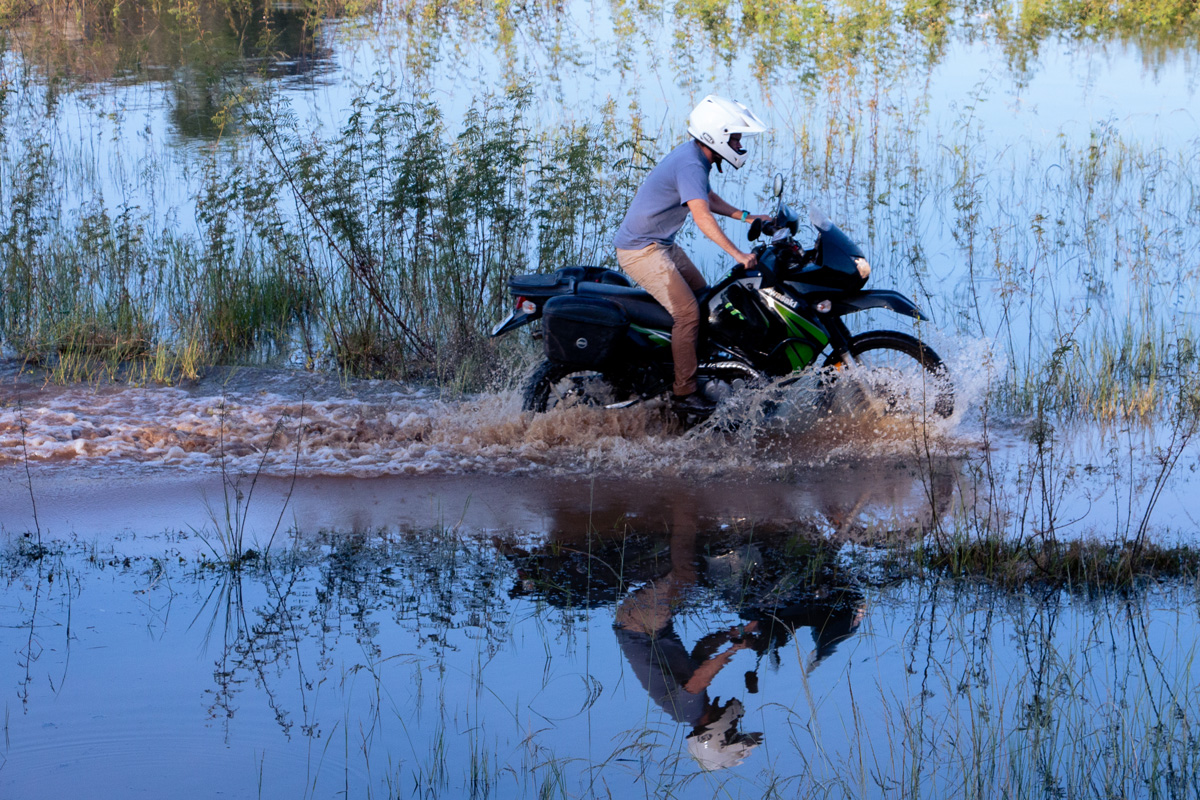
The brief was simple. On the first day of a long weekend, my wife, Nora, and I would ride out of Solwezi, in North-Western Zambia, and make our way East. The first 150 km would be on tar, before we turned to the road less travelled, and completed a 700 km off-road loop around three provinces of the country. We’d forge rivers, climb mountains, and most importantly, escape for a while.
For weeks I’d been plotting our route. I’d used satellite images, open-source maps, and even some phone calls to tap into local knowledge. In spite of this, I still knew very little about the remote roads and trails we’d be riding on. Satellite imagery in one area hadn’t been updated in a decade, and in other areas, the various online maps couldn’t agree where there was a road and where there wasn’t. It was what I refer to as Eskom research: it barely illuminates.
To make things even more interesting, hurricane Freddy had sent a platoon of clouds inland, and our weather forecast had turned from sunny skies to flood warnings. Did it occur to us that we might cancel or postpone our trip? Not a chance. We packed our flimsy plastic rain jackets and pronounced ourselves ready.
Day One: Solwezi to Chingola
150km: 100% tar
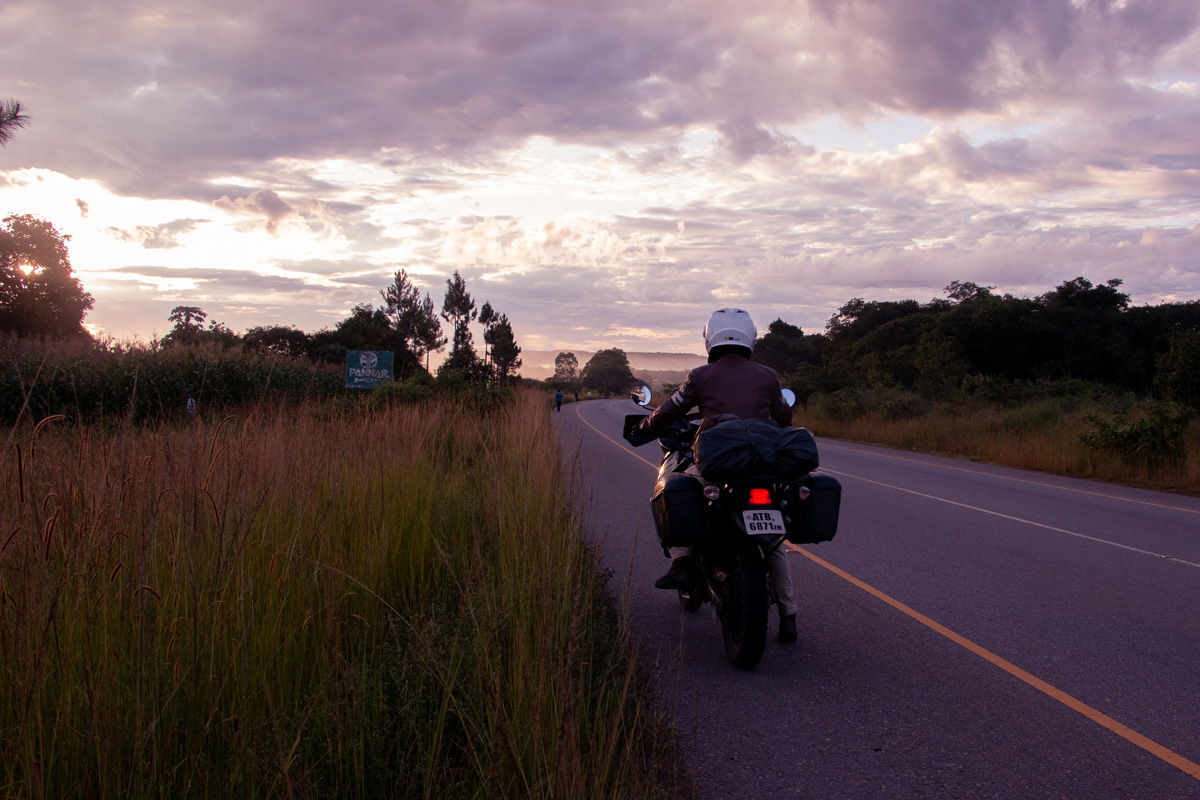
Day one was smooth if a little wet. From Solwezi to the adjacent city of Chingola, we rode 150 km on smooth tarmac, through a few heavy but brief rain showers.
As we sat down to dinner that night, we felt calm and confident. The next day would be our longest: 450 km, all of it on dirt, through many unknown areas. The dirt roads we’d passed on day one were damp, but not soaked. They’d dry out overnight, and we’d blast along them the next morning, chasing each other like Dakar Rally leaders. Our calm, though, was about to meet a storm.
Freddy arrived in the middle of our main course: a rumble coming down from the restaurant roof. Each time it seemed to have reached its climax, it found another pitch and rained harder. I walked to the hotel lobby and peered outside. A river flowed across the lawn. I do not mean a stream. I mean a river.
Water gushed from the roof, pouring out of the gutters. Trees swayed and strained, losing their leaves and even some branches.
I leaned across to Nora and, over the cacophony of the storm I said, “I think it might be muddy tomorrow.” This is the sort of statement for which the word understatement was written.
Day Two: Chingola to Mulungushi
450km: 95% dirt, 5% sludge
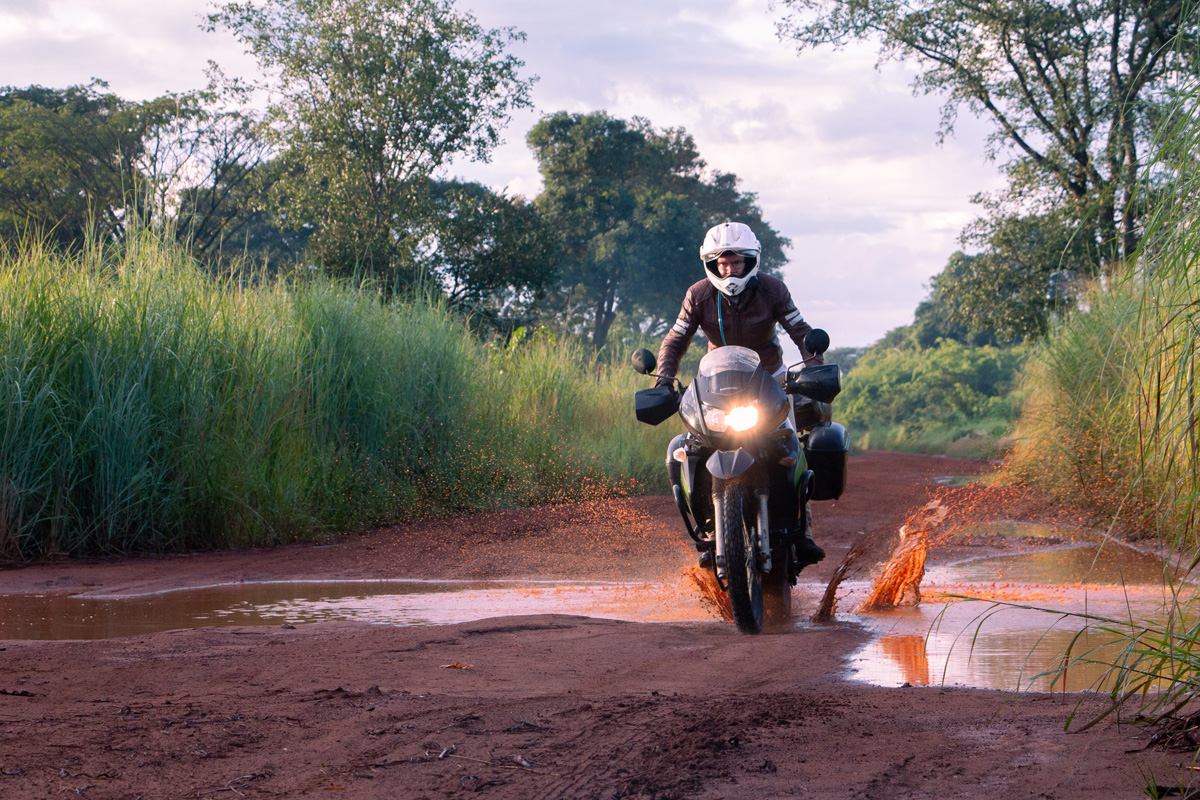
The storm had cleared when we rode out of Chingola that morning. Mist rose from the soaking wet soil, and the air smelled fresh and clean. A few kilometres out of town, we pulled to the edge of the tarmac and looked down a muddy gravel road. This would be our farewell to tar: our farewell to traction, control, and average speeds above those of recreational cyclists. We pointed our bikes right into the muddy unknown and set off for a journey into the sopping-wet centre of Zambia.
At first, all seemed well. We wove our way between puddles and splashed through the odd one. We even stopped to take pictures in the golden morning light. As we set off again, a man on a bicycle rode past with a queen-size mattress folded and strapped to the carrier rack.
About 20 km into the dirt we entered the tribal lands, and the maintained gravel ended. Our tires encountered wet clay, and both of our bikes went sideways. Ahead of me, Nora cross-rutted and went down harder than South Africa’s credit rating.
I came to a less-than-controlled stop, dropped my kickstand, and climbed off my bike to help her. As I did so, my kickstand embarked on a journey towards the centre of the earth, and my bike toppled over.
With the sun now shining, the temperature had risen significantly, and the humidity sat firmly at 100%, so picking up the two loaded bikes was a sweaty affair. While we were at it, I heard the jingle of a bicycle bell, as the man with the mattress trundled on past.
It took us four hours to complete the next forty kilometres. The man with the mattress passed us, and we passed him, and he passed us again. Every now and then, grasslands gave way to beautiful indigenous forests, with trees towering perhaps forty metres high, and beautifully grippy jeep tracks on the forest floor. Then we’d emerge into clay grasslands again, and every inch would be a battle.
At one point, an old man came along on a Chinese 125 cc farm bike. Rather than try to avoid the mud, he rode right down the middle of the deep ruts made by logging trucks. He seemed to find traction down there, so we tried it too.
I wouldn’t say that what we found down there was traction, but as our wheels were at the bottom of the ruts the bikes stayed somewhat straight, and our rate of progress improved just a little.
Picking up my bike for the sixty-third time, I’d got it about halfway up when my feet started to slide one way, and both wheels slid the other. Slowly I slid back down until both the bike and I lay flat in the mud.
I contemplated putting rocks beside the wheels to hold them in place while I picked up the bike, but there were no rocks: there was nothing but mud. Fortunately, the man with the mattress appeared once again, and set aside his ambitions of victory in our tortoise-hare derby to help me up. The two of us slipped and struggled, and basically ran in place as we pushed the bike up to its balancing point.
When we stopped for brunch, around ten in the morning, we’d been riding for four hours and had done 58 km out of 450. The going got no easier for another fifteen kilometres.
Muddy, bruised and exhausted, we finally pulled onto a major gravel road around lunchtime. Part of me wished we’d been on enduro bikes, but I doubt they’d have been any easier to control: just easier to pick up.
On the smooth and grippy gravel, we picked up our pace and were able to sit quite comfortably at 80 km/h for a few hours. We crossed into Zambia’s Copperbelt province, and then into the central province, and there it was dry enough that our bikes even kicked up some dust.
I was not just relieved but genuinely surprised when we finally arrived at Mulungushi Dam at four that afternoon.
Mulungushi is a curious attraction in Zambia. The dam stretches 20 kilometres at its longest, three at its widest, and is cut off from Zambia’s abundant crocodile population by a 100-metre-high waterfall. At its southern bank, a series of rocky ridges make for great hiking and enduro riding, and there’s even a cave that runs into one of the hills and right out the other side.
Day Three: Mulungushi Out & Back
80km: 80% twin track, 20% singletrack
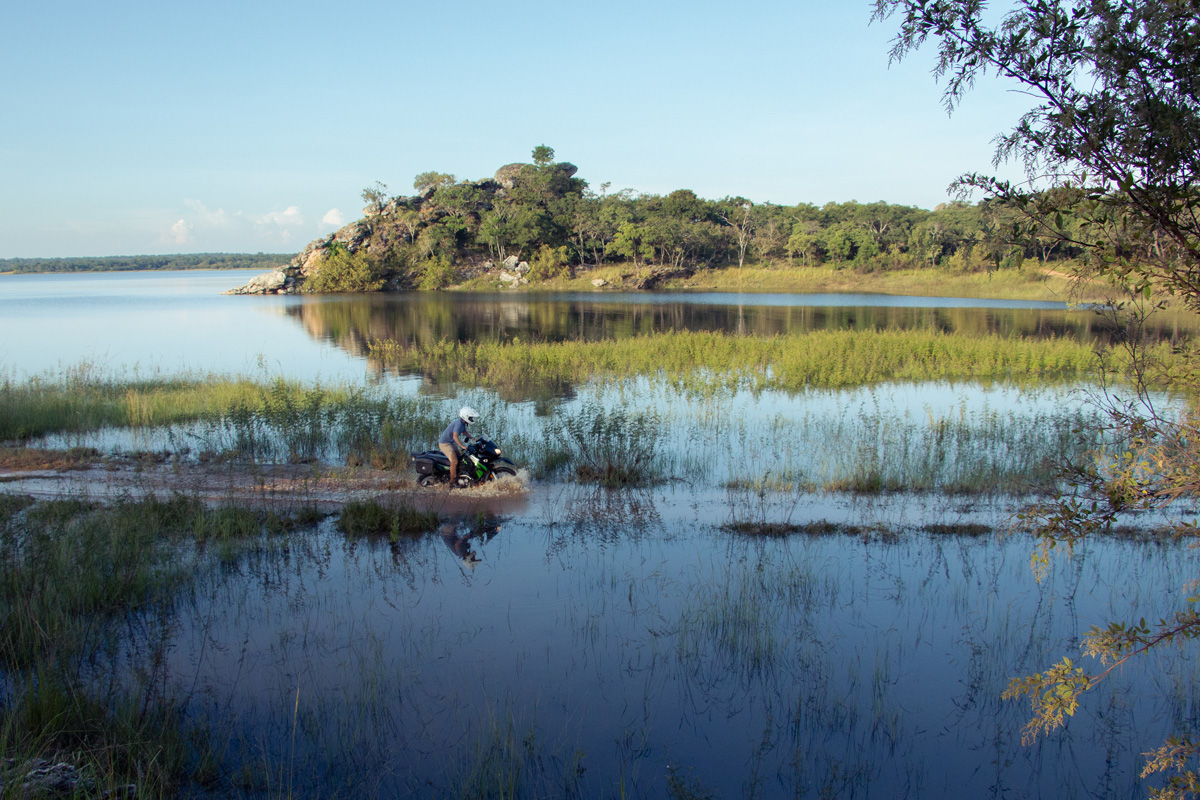
According to the map, a twin-track road winds its way through the villages south of Mulungushi, and then off the edge of the Muchinga escarpment. In just three kilometres, it drops 500 metres to the valley floor below. This sounded like fun riding, and we planned to check it out.
We woke on mission day, aching but undeterred. This day’s trip would be out and (hopefully) back, so we carried nothing but our water packs. Feeling extra optimistic, and tired of picking up a heavy bike, I even decided to leave my tool pack behind.
Zambia’s tribal lands are open to anyone, and they cover more than half of the country’s area. Footpaths and twin-track roads crisscross through the forests and hills, and in theory, you can use them to get from anywhere to anywhere in the country.
We rode out on another misty morning, winding our way along smooth trails towards the edge of the escarpment. For the less masochistic adventure rider, this section was bliss. Footpaths the width of small roads wove through the forests, smooth and fast. It felt like an adventure rider’s Isle of Man TT, as we leaned into each slightly sandy corner and let the big thumpers blast us out at full throttle.
After about forty kilometres of this, the paths dipped down, and we crossed a turquoise-coloured mountain stream. After the crossing, the path turned steep and rocky, pointing up to the top of a wooded hill. We kept our weight back for traction on the loose stones, and let the low-end torque of the KLRs drag us up to the top.
As we wound our way down the other side, the path got steeper and more technical. Eventually, we found ourselves in all-out enduro territory. A steep erosion gully brought us into a river bed, and the climb out the other side was a rut so deep that it came up to our handlebars, and so narrow that we couldn’t keep our feet on the pegs. I rode out with my feet on top of the fuel tank!
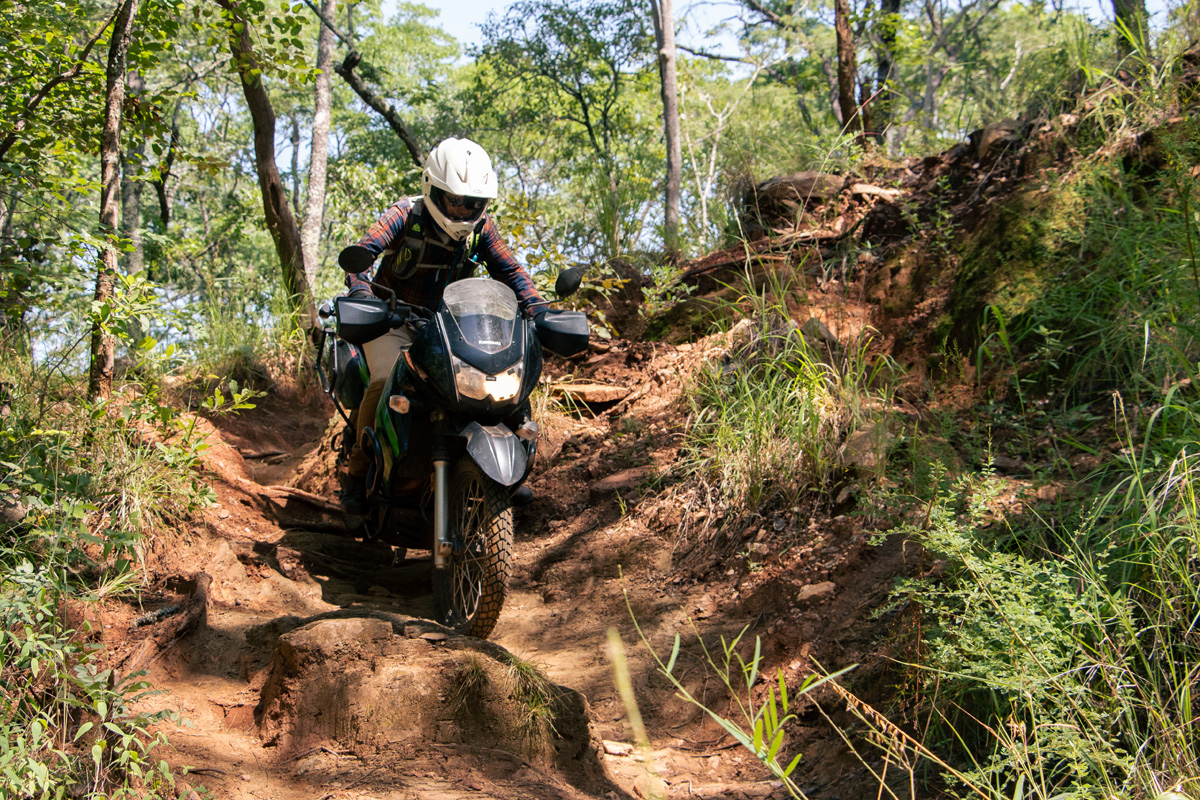
Another kilometre of tough trails brought us to the edge. Quite suddenly, the land dropped away ahead of us, revealing a 500-metre-deep valley a hundred kilometres wide. The view was stunning but frustratingly difficult to see through the trees. This is both the best and worst thing about travelling in Zambia; its tourism is not man-made, and not made for man. Getting to the country’s best parts demands the genuine struggle of adventure. It is a genuine adventure.
Because the last kilometre was so steep and technical, it took us a while to notice that Nora’s bike was stuck in first gear. I had ridden it through the most technical sections for her, and in one of them, I’d slammed the crash bars against a rock. This had moved the left crash bar back, and wedged it against the gear lever. With only a Leatherman available, we had no choice but to bend the lever by hand until it could move freely.
We spent a while at the edge and tried to find the waterfall where the turquoise river dropped into the escarpment. This turned into an adventure of its own, as we abandoned the goat paths and rode along the forest floor. Eventually, though, the descent became so steep that I had to lie my bike down just to stop its momentum, and I was very worried about how I’d get back up the hill.
A lesson here about adventure bikes: they have the power to ride up almost anything, but are often too heavy to control when riding down.
I picked my bike up again, and let that dependable big piston pull me up the hill.
Day Four: Mulungushi to Nsobe
240km: 100% off-road

We were too exhausted to leave early, so we slept in and hit the gravel at about nine in the morning. We covered the first fifty kilometres in forty minutes, cruising along well-maintained gravel. Traveller’s tip: the country is crisscrossed with such roads, but on the maps, you can’t distinguish them from unrideable, rutted bush tracks. The gamble is all a part of the fun.
For the second fifty kilometres, we wound along a fantastic jeep track. We hit the 100 km mark in under two hours, and I remember thinking to myself, we’ll be there for lunch!
We barely made it in time for supper. Halfway through the day, we turned onto another ridiculously muddy track, and our progress ground to a near halt. I had a crash when I rounded a corner and hit a patch of clay slicker than Jacob Zuma’s cronies. Fortunately, it was so slippery that I just lay down and slid along, and nothing broke or hurt.
Nora crashed a bit harder when a patch of mud proved softer than expected. Her front wheel dropped into the mud, caught an invisible edge below the surface, and threw her over the bars.
I won’t dwell on how slow and painful our progress became, because we’ve had enough of that already. What I will say is, in Zambia, it does not rain at all between April and November. Plan your off-road trips for this window.
We enjoyed a few deep river crossings, where what we thought was a foot deep turned out to be three feet deep, and we had no choice but to hold on and throttle out. I do enjoy a good river crossing.
As we approached Nsobe, we found ourselves once again on a very well-maintained piece of gravel, doing 100 km/h. We pulled into Nsobe Nature Reserve as the sun went down, and enjoyed a supper of impala chops in our filthy, wet kit.
Day Five: Nsobe to Solwezi
300 km: 50% dirt
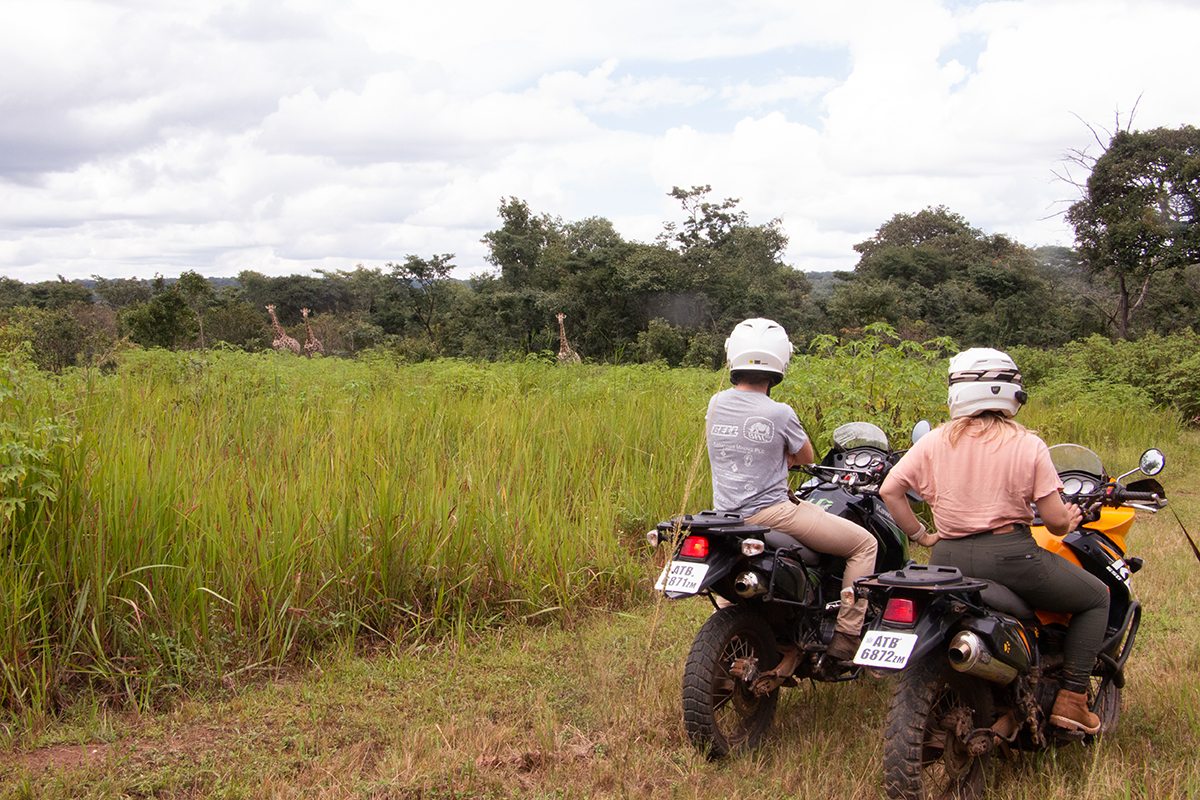
Our final day featured less of the unknown, so we decided to kick it off with some extra riding.
Nsobe Nature Reserve is free of large carnivores, which sounds like a bad thing, but it does mean that you can take yourself for a self-guided motorbike safari, and see the animals.
We cruised along more wonderful jeep tracks and saw large herds of Eiland, wildebeest and zebra. Then we got even luckier. As we rounded a corner in the forest, a clearing opened up ahead of us, and there stood a herd of six giraffes. The three babies hid in the trees, while the parents stepped toward us, as though standing guard. We killed our engines and sat quietly watching the giraffes as they watched us. We could have spent all morning, but with 300 km still to do, it was time to clip our panniers on and hit the road.
The final day proved uneventful; good gravel gave way to even better tar. I’m a passionate off-road rider, but after the weekend’s ordeal, I was overjoyed to see miles of perfect tarmac stretching out ahead of me.
Early that Monday afternoon, our bikes and bodies all battered and our thirst for adventure thoroughly quenched, we rode into our house in Solwezi. We unclipped our panniers and returned to what most of what our species refer to as planet Earth, with only one question on our minds; where next?
Ryan Ellis
[email protected]




